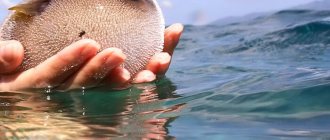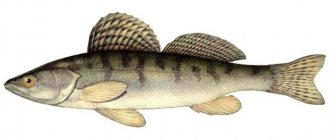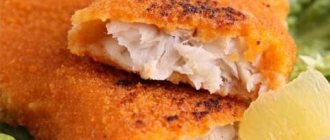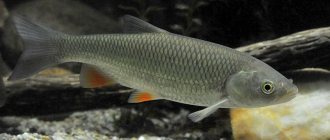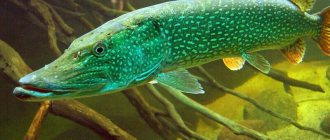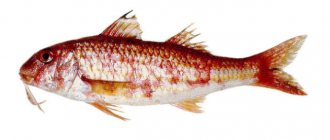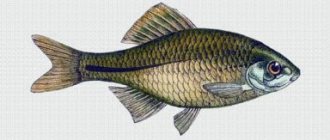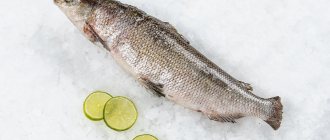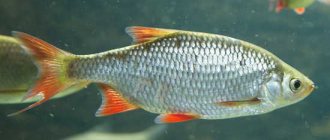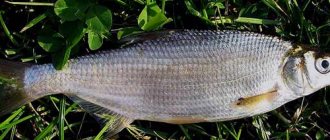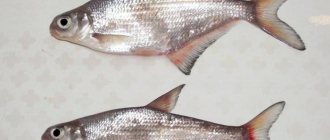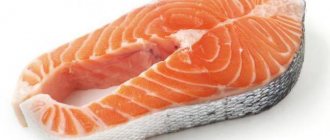Gorchak fish is a small underwater inhabitant of the carp family. There are several subspecies of this representative of the ichthyofauna that inhabit many reservoirs of our country. It is most widely found in Europe, the Amur basin, the Far East and Sakhalin. It is a rare visitor to northern latitudes because it does not breed in cold waters.
Among the people, mustard has received many names. Depending on the region, it may be called alder, garva, pukasik, sinyavka, bitterweed, bitterweed, little one and others. Under these nicknames are hidden various subspecies of this small inhabitant of reservoirs.
The gastronomic properties of mustard are questionable. In this regard, the fish is not particularly valuable. Its meat has a bitter taste, which is why it got its name. If you confuse it with crucian carp or other small fish, it will certainly ruin the taste of the dish.
Varieties and appearance
The main genus-forming representative is the common bitterweed (Rhodeus sericeus), which is known in many regions under various common names: bitterweed, little weed, blueweed, alder, bitterweed. The visual resemblance to one of its distant relatives became the reason for the appearance of the popular nickname - bitter crucian carp.
Inhabits the European part of Russia and the Far East, numerous in the basins of the Caspian, Azov, Black and Baltic seas (Volga, Oka, Moksha, Don, Kuban, Neva). The maximum lifespan is 6 years, during which individual individuals grow up to 12 cm and gain a weight of 20-25 g. At the same time, the average size of the fish does not exceed 5-7 cm and weighs 13-15 g.
Thanks to the characteristic external features, bitterling is easy to distinguish from other representatives of freshwater ichthyofauna:
- high body in the shape of an oval with a sharp thinning in the tail area;
- large cycloid scales of silvery color (34-39 pieces in a row);
- a shortened lateral line that does not reach the vertical drawn from the first ray of the elongated dorsal fin;
- large eyes with a red spot on the iris;
- longitudinal greenish stripe in the tail;
- bluish back with an emerald tint;
- light milky belly.
Depending on the season, the color scheme of the body color can change significantly. For example, during the spawning period, the backs of males become almost purple, and the sides and fins acquire a purplish tint.
To learn more:
Silver carp: description, habits, fishing and benefits of fish
Gorchak Light
The small nominative subspecies (Rhodeus lighti) lives in China and the Russian Far East - some tributaries of the Amur, rivers of the Ussuri basin, Primorsky Territory. It grows up to 5-6 cm in length and has a bright color: a greenish back, pink and blue spots near the edge of the gill covers, and an ultramarine stripe on the tail. The main diet of the fish consists of zooplankton, larvae, mosquitoes, and small algae. The ability to reproduce occurs in the second year of life with a height of 3.0-3.5 cm. The sex ratio in the flock is usually 1:1.
Amur Gorchak
Representatives of the species (Rhodeus amarus) live in Mongolia, China, Sakhalin, Khabarovsk Territory, Jewish OA, in small and large rivers of the basin of the Sea of Okhotsk and the Sea of Japan. They prefer places with stagnant or slow-flowing water, where their favorite food, filamentous algae, is abundant. In terms of external features, the fish is similar to an ordinary bitterling, but has darker color tones.
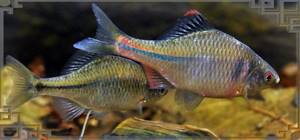
Ocellated bitterweed
The subspecies (Rhodeus ocellatus) lives in Central Asia and has a characteristic eye-spot on the surface of the dorsal fin. The fish is characterized by lemon-yellowish tones of color.
Prickly bitterling
The species Acanthorhodeus asmussi deserves special attention, which, although it belongs to a different genus, is close in habits and appearance to Rhodeus sericeus. Features of the fish are a semi-lower mouth, a black stripe on the caudal peduncle and a large size, sometimes reaching 15-16 cm. In addition to plant foods, it happily eats chironomid larvae and the smallest crustaceans. Inhabits water bodies in the lower part of the Amur basin, also lives in Korea, northeast China, and Mongolia.
Description of appearance
Gorchak is very similar to a small carp or crucian carp. It has a tall body with a medium head, small mouth and eyes. The dorsal fin is elongated, the rest are of normal length. The fish is covered with medium-sized silvery scales, which turn white closer to the belly.
Gorchak grows up to 10–12 cm. The most common specimens are 5–7 cm long. Moreover, its weight is up to 20 grams. The fish lives on average 5–6 years. In general, its size is determined by living conditions, the composition of the food supply and the number of predators inhabiting the reservoir.
Despite its miniature size, the bluefish is a very beautiful and memorable fish.
Its appearance changes depending on the time of year. The mating attire of this underwater inhabitant is especially striking. During this period, the male turns purple and his fins acquire a bright reddish color. The female is more faded and has a pink-pearl tint. Important!
All subspecies of bitterlings, despite their habitat, change color to mating color during the spawning period. Today, about 20 subspecies of this representative of cyprinids are known. The most common are common bitter and Amur. The rest are found in limited climatic zones. Many representatives of this “brotherhood” live in the waters of China and Vietnam.
The common mustard inhabits the waters of Europe. Its distribution range is from the Volga to the rivers of France. The Amur lives in large numbers in the Far East, Mongolia and China. Both subspecies do not represent any commercial value and are considered trash fish.
Lifestyle and behavior
Gorchaki move in flocks, avoiding fast currents and heavily swampy water bodies with oxygen deficiency. The optimal habitat for the population is quiet and calm streams, creeks, and small tributaries. Due to its small size, the fish needs constant reliable shelter, which is provided by coastal vegetation thickets, stones and snags at depths of 0.5-2 meters. Gorchak constantly lives in the bottom layers or on the ground. The basic food is unicellular and colonial algae (diatoms, eudorina, gonium) and plants. To a lesser extent, the diet contains zooplankton, crustaceans, larvae, and worms.
To learn more:
Common loach and Amur loach: lifestyle, spawning and fishing
The main biological and feeding activity of the fish occurs during daylight hours. She spends the night in shelter, avoiding dangerous encounters with perch, burbot, pike and pike perch. But even if detected, the fish still has a chance to escape due to its high speed of movement and excellent maneuverability.
Relations within the flock and between different species of bitterlings are quite peaceful - they coexist without problems in the same territory, without showing intense food competition. Temporary difficulties in communication can arise only between males during the breeding season.

Description of bitter fish
Appearance
This fish is distinguished by a high, laterally compressed body, which is covered with fairly large scales. The bitterling has a small head, medium-sized eyes, and no mustache. The mouth of the bitterling located below is small in size. On the silvery sides there are narrow stripes running along the body, usually bluish or greenish in color.
When the bitterling goes to spawn, the bellies and sides of the males become a very bright rainbow color. This is a fairly small fish - usually during its life, the bitterling grows to a maximum length of eight to ten centimeters. The average size of the most commonly encountered bitterling specimens is seven centimeters, and their weight is about five to eight grams.
Gorchak usually lives up to the age of five. This fish lives in schools in reservoirs with stagnant water, and prefers to stay at the bottom.
It feeds mainly on algae and plankton. Fish has many synonymous names in Russia. Thus, our fellow countrymen also call bitterweed alder, bitterweed, little bitch, little bitterweed, bitterweed or blueweed. Due to the fact that the bitter crucian is somewhat reminiscent of a small crucian carp, it is sometimes called “bitter crucian carp.”
Habitat
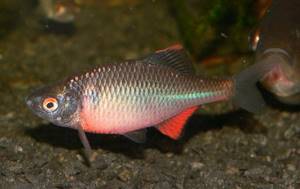
There are several species of bitterlings, each of which has its own habitat. But in general, bitterling is found where mollusks of the genus Unio and Anodonta live, because the life cycle of bitterling is associated with them.
Thus, common mustard is found in European countries, in such reservoirs as the Seine River, Volga River and Neva River. It is also common in rivers flowing into the Baltic Sea and Black Sea, as well as rivers flowing into the Aegean Sea.
In Russia, this fish is most often found in the northwest - in the Neva River and its tributaries. In addition, bitterweed is not uncommon in the Volga regions of our country - it is found, for example, in the Volga, the Chapaevka River (Samara region). Also, bitterling is often found in the Caspian Sea.
In turn, Amur bitterling has become quite widespread in Asian regions - China, South Korea, Vietnam and Mongolia, as well as in the Asian part of Russia. Thus, it can be found in the Amur River, the Sea of Japan and the river basins of the Seas of Okhotsk and the Sea of Japan, as well as in one of the easternmost points of Russia - on Sakhalin, in the Poronai and Tym rivers.
Despite the fact that bitterling is not a commercial fish, it is often found here. In Ukraine, bitterling can be found in the southwestern regions of the country, and in Belarus it is common, for example, in Polesie.
In northern latitudes, this fish is found extremely rarely, since in cold water it has problems with reproduction. However, bitterling can often be found in places completely unusual for it.
Spawning
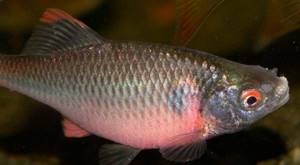
During the breeding season, bitterling changes its appearance. Thus, the sides and back of males become bright purple, and the fins become bright pink. The male bitterling looks like a real beauty during spawning.
However, the females also transform. They acquire a pink color (though not as bright as that of males, much paler), and they also grow an oviduct up to 5 centimeters long. As the female spawns, the oviduct will shrink, and when spawning is completed, it will turn into only a barely noticeable red tubercle.
During the spawning period, males actively compete for females, drive away rivals from her, push away and pursue. However, since there are usually a sufficient number of bitterling females, competition among males is usually quite moderate.
The bitterling becomes sexually mature around the third year of its life, when its length reaches three to four centimeters. The female usually lays eggs during the spring and summer in the cavity of the mollusks. The shape of the eggs is oval, they reach a diameter of up to three mm. On average, a female bottom produces from 200 to 400 eggs, while several bitterling females can lay eggs in the same mollusk at once.
After a few weeks (usually two to three weeks), the eggs emerge from the mollusk. At the same time, the mollusk embryos attach to the bitterlings themselves, thus parasitizing and also moving within rivers and lakes.
Fishing
This fish has no commercial value because it is very small in size and also has a bitter taste. It is from this taste that it got its name - bitter. The bitterness is associated with the algae that these fish feed on.
Fishing for bitterling is also not common. Few people managed to catch her. However, you can try to catch bitterling for bread, but if you catch it, you should know that this is a very rare case.
They catch bitterlings with the help of a “spider” or a brand in order to later use them as bait for larger and tastier fish.
Catching a bitterling with a fishing rod is a matter of luck. This fish can bite on bread, but this is very rare. It is mainly caught with the help of the so-called “spider”. The bitterling is caught by fishermen for the purpose of using it as live bait for larger, better-tasting fish.
Spawning bitterling
The spawning process is unusual and involves the use of a “natural incubator” in the form of a living bivalve mollusk from the Unionidae family. More often it is an oval-shaped pearl barley (lat. Unio) or a more rounded toothless barley (Anodonta). The absence of these types of shells in a particular region or body of water has a key impact on the formation of the discontinuous habitat of the bluefish, since the fish itself is distinguished by its vitality and adaptability to environmental conditions. It feels excellent both in cold and in water of any quality heated to +25-30°C, which cannot be said about heat-loving mollusks that are sensitive to pollution.
Spawning in bitterling occurs in several stages from May to August. At this time, sexually mature males (from 2-3 years old) are covered with a bright mating color in purple-red tones and fight among themselves for females and bivalves, inside which the larva will develop. In females, in the area of the anal fin, a transparent organ grows - an oviduct tube 4-5 cm long, densely filled with yellow eggs (200-250 pieces).
During spawning, the fish, using a tubular organ, lays a portion of eggs (5-30) inside the mantle of the shell. The male sends his milk there. If a “free” pearl barley or toothless clam is nearby, the throwing process is temporarily suspended until a new mollusk is discovered. It is not uncommon for the same shell to be home to 10-15 clutches of different females. As the eggs are spawned in batches, the oviduct shortens until it disappears.
To learn more:
Description and characteristics of European grayling

After 3-4 days, larvae appear in the mantle cavity of the mollusk, which do not lead a parasitic lifestyle, but receive the substances necessary for development from the yolk sac. The grown fry feeds on plankton, and after 17-20 days it leaves the shelter and introduces plant food into its diet.
The relationship between bitterlings and toothless ones (pearls) is a mutually beneficial symbiosis. The shell creates greenhouse conditions for all stages of development of eggs and fry. In turn, small fish help increase the population of bivalves by removing from the “incubator” the larvae of young mollusks (glochidia), which are attached to the scales with a special hook.
Features of spawning
The bluebird is distinguished by an unusual spawning process. The peculiarity is that the fish uses a “natural incubator” - a living mollusk, which belongs to the Unionidae family. Spawning occurs in several stages, which last from May to August. During the mating season, males acquire a purple-red color and begin to fight among themselves for the attention of females. At the same time, they “pick up” bivalves in which the larva will develop.
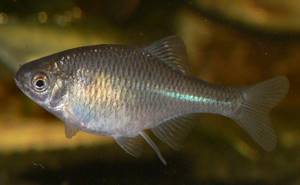
They use a live mollusk to lay their eggs.
Females have a transparent organ in the form of an oviduct. It can reach 4 to 5 cm in length. This oviduct is densely filled with yellow eggs. There are about 200−250 of them in total. During spawning with a tubular organ, eggs are laid in shells. One can fit from 5 to 30 pieces. The male places milt in the same shell. Sometimes it happens that one shell can contain from 10 to 15 clutches.
Larvae begin to appear after 3-4 days. The basis of the fry’s diet is plankton, and after 17-20 days the diet already includes plant food.
Catching bitterling
The best place for fishing is a quiet bay or stretch with an abundance of aquatic vegetation. The fish does not like great depths due to the lack of main food - colonies of unicellular algae, which do not develop well in low light conditions. For successful fishing of bitterling, a float rod with lightweight equipment and a small hook with a short shank is suitable. It is important to use a leash that is an order of magnitude thinner than the main line, so that in the event of a possible snag on plants, the tackle will not be broken.
The favorite attachment of the bruise is crumb of rye bread or dough with the addition of anise flavoring. Bloodworms, maggots, pieces of worms, steamed pearl barley, and canned corn are considered less catchable.
The bite of bitterling is similar to the manner of swallowing food by crucian carp or bream. The fish carefully takes the bait into its mouth and lifts it slightly, as a result of which the float lies on the surface of the water. At this moment you need to perform a sharp, but not strong hook.
Keeping in an aquarium
All types of bitterlings are suitable for breeding in a home tank. The fish is unpretentious, has a strong immune system, is friendly and feels great at a constant water temperature of +18-22°C. Among other microclimatic indicators of the environment, hardness (dH 12-150, maximum up to 200) and acidity (pH = 6.8-7.5) are important. Good filtration and aeration, weekly addition of settled water (1/4 of the container), and bottom cleaning of excess organic waste are also necessary.
Under natural conditions, bitterling lives on a sandy bottom, so the aquarium needs fine rocky soil with a layer of 5-7 cm. It is also desirable to have natural plants with a developed root system, since most cyprinids can easily dig them up.
To learn more:
What is bleak and where does it live?
Under artificial conditions, the fish willingly eats animal plant food, flakes, granules, and bread. The optimal settlement option is a flock of 5-7 individuals, preferably with a quantitative predominance of females.
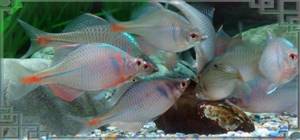
Artificial breeding
Reproduction of bitterling in captivity is no different from the natural process and requires live bivalves. It is important to take into account here that the toothless ones are less whimsical than the pearl barleys, which die when there is a lack of oxygen. For normal maturation of eggs in the female’s body, experienced aquarists take into account the pronounced seasonality of the species, so during March and April they are kept in cool water (+10-120°C). A gradual increase in temperature to +18-24°C is clearly perceived by fish as the time to spawn.
